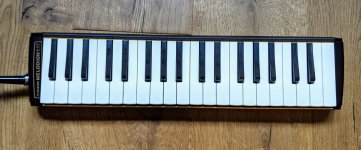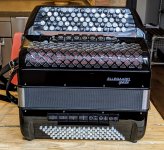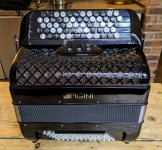You are using an out of date browser. It may not display this or other websites correctly.
You should upgrade or use an alternative browser.
You should upgrade or use an alternative browser.
Characteristic sound of each brand
- Thread starter craigd
- Start date
- Status
- Not open for further replies.
#2 indeed does not sound too bad, but mostly on the white keys. The black keys I don't like so much. #3 is pretty horrible (I get a déjà vu feeling of Golden Cup...) and #4 does not sound nice, but this is what you typically get with lower end non-cassotto accordions, or when a cassotto instrument is played on the H register or the out-of-cassotto M register. That is a useful sound in an ensemble though. I regularly make arrangements for accordion ensemble of music written for strings and woodwind, and such a sound is useful to emulate the oboe sound.I still prefer #2.
Here is an example. You hear my emulation of strings on the left and of oboes on the right. (Wait a bit because the oboes only come in after 8 bars). I would not like an ensemble with all the accordions sounding like this, but to have an ensemble with as many different sounds as possible it is usefule. The "oboes" were played using the H register (played an octave lower) on my AKKO bayan.
Dingo40
Been here for ages!
This is beginning to remind me of a documentary I once saw on TV concerning a double-blind experiment, performed to see If a selected audience could identify the Stradivarius out of a series of violins played one at a time on stage behind a curtain.
The result?
The Stradivarius remained unidentified, a modern instrument having been mistaken for it by the panelists !?
It makes one wonder what is "real" and what only imagined ?
The result?
The Stradivarius remained unidentified, a modern instrument having been mistaken for it by the panelists !?
It makes one wonder what is "real" and what only imagined ?
Last edited:
Heres a challenge!
Have a listen to clips 1, 2 and 3.
Are any of these Pigini or not? And which reed sounds nicest?
They all sound surprisingly reedy, especially 1 and 3, even a bit of 2, so I didn't think cassotto. I did think 1 might be a harmonica, melodica didn't occur to me. If there is a Pigini in there it must be #2.
Thanks for all your replies to the quiz.
#1 is a melodica - well done Paul! Nice to see how many people liked the sound too.
#2 and #3 are both accordions but neither has cassotto so that's interesting given peoples responses.
I'm going to now get rid of #1 (the melodica) and add in a new entry #4. See what you think to different sounds below.
accordion #2
accordion #3
accordion #4 (the new entry!)
Nice bit of music! I think the reedy sound of #3 works well with the baroque tune. I couldn't even take a stab at the accordion maker. The last one makes me think of an accordina. Are they CBAs?
I only need a few seconds to recognize whether it's a Pigini or not...
Thanks for all the replies. Here are the answers:
Instrument #1
Suzuki melodica

All the accordions were played on L register, none had cassotto.
Accordion #2
Pigini - an old medium sized one

Accordion #3
Pigini - a middle aged larger one

Accordion #4
Pigini - a new little one

Dingo40
Been here for ages!
All the actual accordions were Piginis: no wonder we couldn't tell 2,3,&4 appart!?
Thanks, Saunders, quite stimulating!??
Thanks, Saunders, quite stimulating!??
Thanks for the answers. I guess quality isn't what it used to be... #2 definitely has the "best" sound, but it suffers from the first row of pallets being under the solid part of the grille (and the registers), giving these notes a different sound then the other two rows (under the open part of the grille). Many accordions have this problem. Cassotto accordions have that too as reed blocks are at different depth inside the cassotto.
Accordion #3 is really in trouble. I mistook it for a cheap chinese one because it sounds way too sharp on some reeds, and the noise of pressing and releasing the keys is excessive.
Accordion #4 is indeed a small student model but it is definitely in better shape than #3.
They are all Pigini... who could have guessed. It's no wonder I didn't like the sound of any of them. I just couldn't identify them. I'm used to spotting difference in sound between cassotto accordions being played.
As for the melodica. The way to identify a melodica is not just in the sustained sound of the notes but more in the attack: the sound of notes in a melodica is consistently slow to start and the volume increases during the first few tenths of a second. A harmonica is different, with fast responding reeds that start sounding right away (for all but the lowest notes).
Accordion #3 is really in trouble. I mistook it for a cheap chinese one because it sounds way too sharp on some reeds, and the noise of pressing and releasing the keys is excessive.
Accordion #4 is indeed a small student model but it is definitely in better shape than #3.
They are all Pigini... who could have guessed. It's no wonder I didn't like the sound of any of them. I just couldn't identify them. I'm used to spotting difference in sound between cassotto accordions being played.
As for the melodica. The way to identify a melodica is not just in the sustained sound of the notes but more in the attack: the sound of notes in a melodica is consistently slow to start and the volume increases during the first few tenths of a second. A harmonica is different, with fast responding reeds that start sounding right away (for all but the lowest notes).
Well spotted on the melodica! It was interesting how many people liked that sound. I personally like melodicas and think you can learn a lot about breathing in music and reed speech from them. They are always handy for some impromptu music making too!
I use the accordina instead of a melodica. I prefer the sound of the accordina over that of a melodica. (I prefer the price of the melodica over that of an accordina though...)Well spotted on the melodica! It was interesting how many people liked that sound. I personally like melodicas and think you can learn a lot about breathing in music and reed speech from them. They are always handy for some impromptu music making too!
Thanks for this cool challenge Ben, very informative.Well spotted on the melodica! It was interesting how many people liked that sound. I personally like melodicas and think you can learn a lot about breathing in music and reed speech from them. They are always handy for some impromptu music making too!
Cheers! I think the point of it was to show that often we simply hear/value what we see rather than the sound that is made, and when we can't see it we have to rely on our ears only without visual clues. The unorthodox conclusions people reached pleased me!
In particular the two interesting things were firstly the appreciation by a number of people of what turned out to be the cheapest reed instrument, the melodica. Secondly, the most generally liked accordion (which even the most sagacious ears wrongly identified as cassotto in M register, rather than what it actually was - L without any cassotto) is actually the accordion with the least financial value - an early pigini converter complete with really dirty reeds including some rust!
These two favoured instruments are the ones out of the line up that were actually mine
In particular the two interesting things were firstly the appreciation by a number of people of what turned out to be the cheapest reed instrument, the melodica. Secondly, the most generally liked accordion (which even the most sagacious ears wrongly identified as cassotto in M register, rather than what it actually was - L without any cassotto) is actually the accordion with the least financial value - an early pigini converter complete with really dirty reeds including some rust!
These two favoured instruments are the ones out of the line up that were actually mine
Let me add that in most accordions the L reeds give a more mellow sound than the M reeds. My own explanation for this is that the reed blocks are made to "fit" the l reeds. The M reeds on the opposite side in fact have a bit too much room on the reed block, and this makes them have a different sound. The only accordions I know that have more mellow M than L reeds are the legendary Bell, Scandalli (Super VI) and Hohner Gola and also the Morino (N and S, made by Excelsior).
It may be so that the accordion #2 has the least financial value of the three Pigini accordions, but it does have the nicest sound, which indicates that the Pigini sound (in all but the high-end instruments) certainly has not improved over the decades...
It may be so that the accordion #2 has the least financial value of the three Pigini accordions, but it does have the nicest sound, which indicates that the Pigini sound (in all but the high-end instruments) certainly has not improved over the decades...
All three accordions were Pigini Godgi!
- Status
- Not open for further replies.
Similar threads
- Replies
- 6
- Views
- 225
- Replies
- 5
- Views
- 290
- Replies
- 12
- Views
- 426
